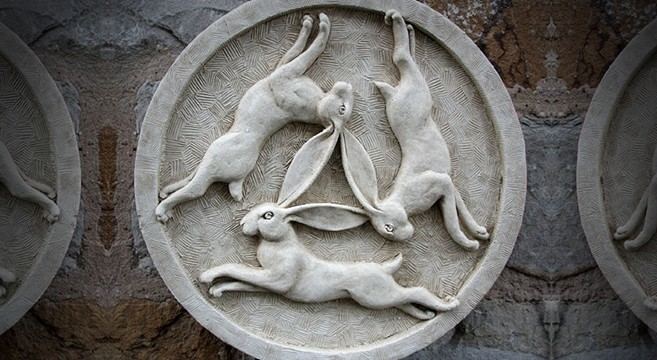 | ||
The three hares is a circular motif appearing in sacred sites from the Middle and Far East to the churches of Devon, England (as the "Tinners' rabbits"), and historical synagogues in Europe. It is used as an architectural ornament, a religious symbol, and in other modern works of art or a logo for adornment (including tattoos), jewelry and a coat of arms on an escutcheon. It is viewed as a puzzle, a topology problem or a visual challenge, and has been rendered as sculpture, drawing, and painting.
Contents
- A Lecture by Dr Sue Andrew
- Origins in Buddhism and diffusion on the Silk Road
- In Christianity
- In Judaism
- As an optical illusion or puzzle
- Other uses and related designs
- References
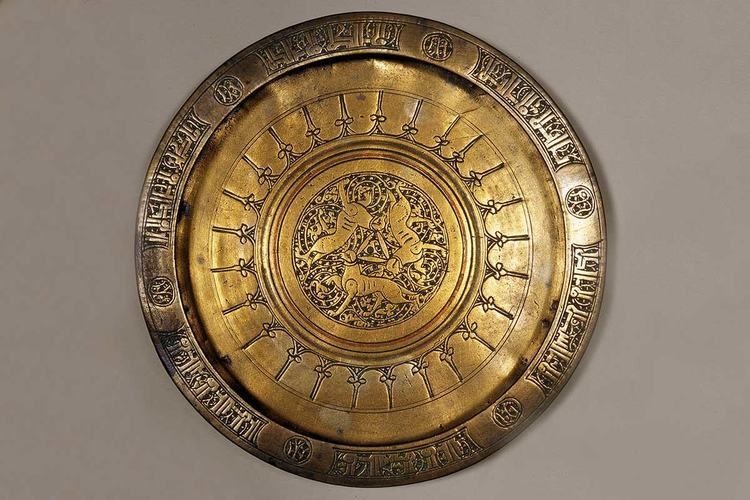
The symbol features three hares or rabbits chasing each other in a circle. Like the triskelion, the triquetra, and their antecedents (e.g., the triple spiral), the symbol of the three hares has a threefold rotational symmetry. Each of the ears is shared by two hares, so that only three ears are shown. Although its meaning is apparently not explained in contemporary written sources from any of the medieval cultures where it is found, it is thought to have a range of symbolic or mystical associations with fertility and the lunar cycle. When used in Christian churches, it is presumed to be a symbol of the Trinity. Its origins and original significance are uncertain, as are the reasons why it appears in such diverse locations. That the image's meaning changes depending upon the context and the viewer could be characterized as being analogous to pareidolia; Its widespread appeal may be characterized as being a meme.
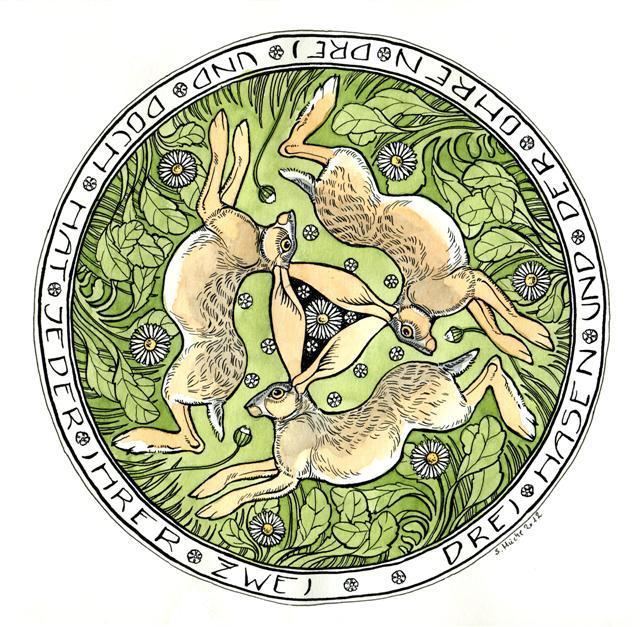
A Lecture by Dr. Sue Andrew
Origins in Buddhism and diffusion on the Silk Road
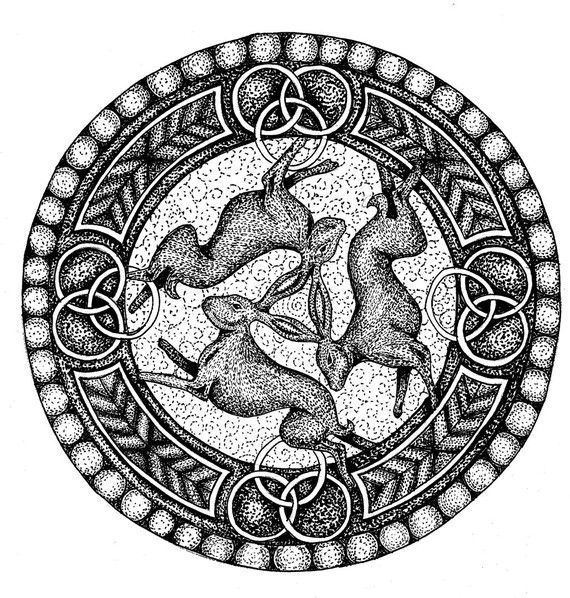
The earliest occurrences appear to be in cave temples in China, dated to the Sui dynasty (6th to 7th centuries). The iconography spread along the Silk Road, and was a symbol associated with Buddhism. The hares have been said to be "A hieroglyph of 'to be'." In other contexts the metaphor has been given different meaning. For example, Guan Youhui, a retired researcher from the Dunhuang Academy, who spent 50 years studying the decorative patterns in the Mogao Caves, believes the three rabbits—"like many images in Chinese folk art that carry auspicious symbolism—represent peace and tranquility." See Aurel Stein. The hares have appeared in Lotus motifs.
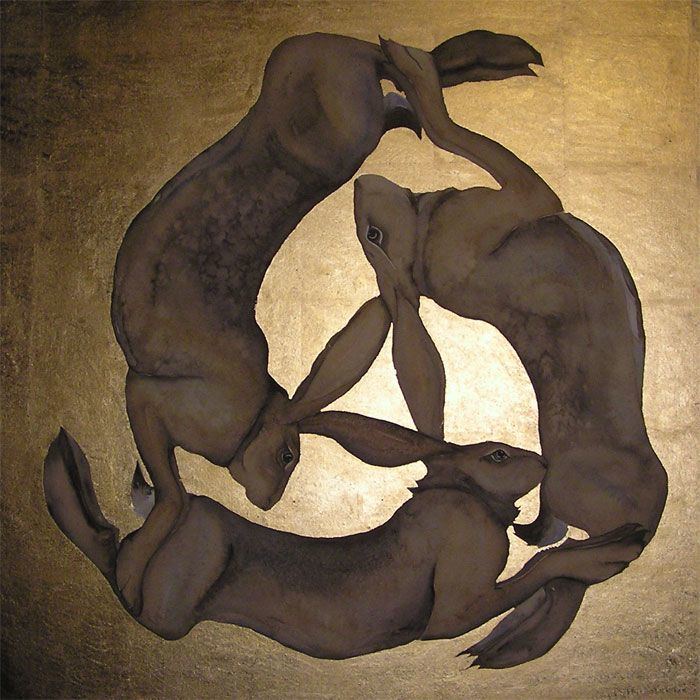
The Three Hares appear on 13th century Mongol metalwork, and on a copper coin, found in Iran, dated to 1281.
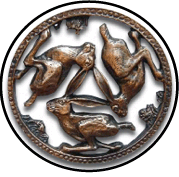
Another appears on an ancient Islamic-made reliquary from southern Russia. Another 13th or early 14th century box, later used as a reliquary, was made in Iran under Mongol rule, and is preserved in the treasury of the Cathedral of Trier in Germany. On its base, the casket has Islamic designs, and originally featured two images of the three hares. One was lost through damage.
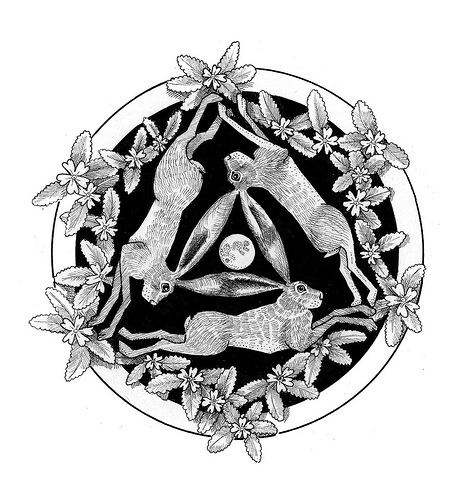
One theory pertaining to the spread of the motif is that it was transported from China across Asia and as far as the south west of England by merchants travelling the silk road and that the motif was transported via designs found on expensive Oriental ceramics. This view is supported by the early date of the surviving occurrences in China. However the majority of representations of the three hares in churches occur in England and northern Germany. This supports a contrary view that the Three Hares occurred independently as English or early German symbols.
Some claim that the Devon name, Tinners' Rabbits, is related to local tin miners adopting it. The mines generated wealth in the region and funded the building and repair of many local churches, and thus the symbol may have been used as a sign of the miners' patronage. The architectural ornament of the Three Hares also occurs in churches that are unrelated to the miners of South West England. Other occurrences in England include floor tiles at Chester Cathedral, stained glass at Long Melford, Suffolk and a ceiling in Scarborough, Yorkshire.
In Christianity
The motif of the Three Hares is used in a number of medieval European churches, particularly in France (e.g., in the Basilica of Notre-Dame de Fourvière in Lyon) and Germany. It occurs with the greatest frequency in the churches of Devon, England. The motif appears in illuminated manuscripts, architectural wood carving, stone carving, window tracery and stained glass. In South Western England there are over thirty recorded examples of the Three Hares appearing on 'roof bosses' (carved wooden knobs) on the ceilings in medieval churches in Devon, (particularly Dartmoor). There is a good example of a roof boss of the Three hares at Widecombe-in-the-Moor, Dartmoor, with another in the town of Tavistock on the edge of the moor. The motif occurs with similar central placement in Synagogues. Another occurrence is on the ossuary that by tradition contained the bones of St. Lazarus.
Where it occurs in England, the Three Hares motif usually appears in a prominent place in the church, such as the central rib of the chancel roof, or on a central rib of the nave. This suggests that the symbol held significance to the church, and casts doubt on the theory that they may have been a masons' or carpenters' signature marks. There are two possible and perhaps concurrent reasons why the Three Hares may have found popularity as a symbol within the church. Firstly, it was widely believed that the hare was hermaphrodite and could reproduce without loss of virginity. This led to an association with the Virgin Mary, with hares sometimes occurring in illuminated manuscripts and Northern European paintings of the Virgin and Christ Child. The other Christian association may have been with the Holy Trinity, representing the "One in Three and Three in One" of which the triangle or three interlocking shapes such as rings are common symbols. In many locations the Three Hares are positioned adjacent to the Green Man, a symbol commonly believed to be associated with the continuance of Anglo-Saxon or Celtic paganism. These juxtapositions may have been created to imply the contrast of the Divine with man's sinful, earthly nature.
In Judaism
In Judaism, the "shafan" in Hebrew has symbolic meaning. Although rabbits are listed as a non-kosher animal in the Bible—they are a ruminant lacking cloven hooves—rabbits can carry very positive symbolic connotations, like lions and eagles. 16th century German scholar Rabbi Yosef Hayim Yerushalmi, saw the rabbits as a symbol of the Diaspora. The replica of the Chodorow Synagogue from Poland (on display at the Museum of the Jewish diaspora in Tel Aviv) has a ceiling with a large central painting which depicts a double headed eagle holds two brown rabbits in its claws without harming them. The painting is surrounded by a citation from the end of Deuteronomy:
This may be translated: "As an eagle that stirreth up her nest, hovereth over her young, spreadeth abroad her wings, taketh them, beareth them on her pinions (...thus is G'd to the Jewish people)."
The hare frequently appears in the form of the symbol of the "rotating rabbits". An ancient German riddle describes this graphic thus:
This intriguing graphic puzzle is present in all renowned wooden synagogues from the 17th and 18th centuries in the Ashkenaz region (Germany), currently exhibited in the Beth Hatefutsoth Museum in Tel Aviv, the Jewish Museum Berlin, and The Israel Museum in Jerusalem. These symbols are also featured in the Synagogue from Horb am Neckar, which was donated to The Israel Museum. The three animals decorate the wooden panels of the prayer room from Unterlimpurg near Schwäbisch Hall, a replica of which can be viewed in the Jewish Museum Berlin. They also are seen in a main exhibit of the Diaspora Museum in Tel Aviv. Israeli art historian Ida Uberman wrote about this house of worship: "... Here we find depictions of three kinds of animals, all organized in circles: eagles, fishes and hares. These three represent the Kabbalistic elements of the world: earth, water and fire/heavens... The fact that they are always three is important, for that number . . . is important in the Kabbalistic context".
Not only do they appear among floral and animal ornaments, but they are often in a distinguished location, directly above the Torah ark, the place where the holy scriptures repose.
They appear on headstones in Sataniv (Сатанів), Khmelnytsky Oblast, western Ukraine.
As an optical illusion or puzzle
The logo presents a problem in topology. It is a strange loop or rendered as a puzzle.
Jurgis Baltrusaitis's 1955 Le Moyen-Âge fantastique. Antiquités et exotismes dans l'art gothique includes a 1576 Dutch engraving with the puzzle given in Dutch and French around the image. It notes:
The secret is not great when one knows it.But it is something to one who does it.Turn and turn again and we will also turn,So that we give pleasure to each of you.And when we have turned, count our ears,It is there, without any disguise, you will find a marvel."These are the oldest known dated examples of the Three Rabbits as a puzzle." One commentator believes its being a puzzle is likely reason for the image's popularity.
One recent philosophical book poses it as a problem in perception and an optical illusion—an example of contour rivalry. Each rabbit can be individually seen as correct—it is only when you try to see all three at once that you see the problem with defining the hares' ears. This is similar to "The Impossible Tribar" by Roger Penrose, originated by Oscar Reutersvärd. Compare M.C. Escher's impossible object.
